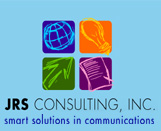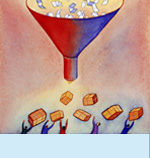


  |
||||
|
PRINTER FRIENDLY VERSION Research Lessons Learned From Bill Cosby, Kenny Rogers, and Rita Moreno: Five Tips for Doing Research that Earns Star Billing I believe that I may be the only market research consultant to have ever worked with celebrities that include Bill Cosby, Kenny Rogers and Rita Moreno. My past work in public relations involved creating alliances between organizations and celebrities who agreed to endorse products or convey public service-oriented messages. Interestingly, the times I spent in limousines, Las Vegas nightclubs or TV Show "green rooms" taught me important lessons that I think apply to consumer and employee research today. (Who says research has to be boring!) Following are five tips for conducting exceptional research that are based on the work I have done with celebrities. 1. Be a class act - Do the right thing and send a powerful message. I remember the day I first met Kenny Rogers like it was yesterday. I arrived to take Kenny from a large meeting of corporate executives to his press interviews on behalf of Dole Pineapple. I slipped in the door, intending to stay in the back until Kenny was ready to go. Kenny saw me come in, stopped the meeting with the Dole CEO and approached to shake my hand, "I'm Kenny Rogers." This was just one example of the way Kenny Rogers treated everyone with respect and made them feel that they mattered. He sent a powerful message that he valued others, from CEOs to press assistants. It is equally important to be a class act and send a powerful message as you conduct research. When speaking with corporate executives regarding interviewing employees, I sometimes hear that they are considering having an internal interviewer speak to employees. At that point, I always ask one simple question, "How likely would you be to talk honestly with your HR person about this?" In every case when I ask this question, the client decides to engage our firm to conduct the interviews. The decision to engage a credible, outside professional interviewer sends a powerful message to employees. Again and again, we hear from employees, "I'm impressed that they've hired you to talk with us. That tells me they do care." Our clients find that the benefits of doing the right kind of research by hiring a professional interviewer begin as soon as the sessions are announced. 2. Keep it short and sweet. I've supervised the creation of numerous corporate videos, ranging from the creation of hot dogs to exercises that can be done while cleaning one's bathroom. (Who could make this up?) But the most effective production that I have ever developed was a public service announcement featuring Bill Cosby reminding people to buckle their seat belts. From the moment we arrived to shoot the video in his dressing room at the Las Vegas Aladdin Hotel, Bill Cosby was focused. We did seven "takes," and could have used any one of them. This was a welcome change from the 38 times we had shot a video with another talent during the previous week. In research, it is also important to stay focused so that you generate applicable findings. It's easy for a research project to become a hodgepodge of topics, including extemporaneous questions and pet projects. While I am always open to incorporating additional areas into a study when we have the opportunity, it's critical to be sure that everyone's time and budgets are utilized most effectively. A good question to ask yourself or your clients when adding questions or areas to a study is, "How are we going to use this information?" If this question can't be answered to everyone's satisfaction, then chances are that the topics under consideration don't need to be addressed. 3. Entertain your audience. Rita Moreno made everything we did enjoyable - including talking about our client, Campbell's Soup. When we met to plan an appearance or interview with the press, she was enthusiastic, engaged with us and generally made us want to be around her. This is a useful approach with research as well. I was recently invited to present findings from interviews that we had conducted with employees in the middle of a large reorganization. My presentation was at the end of a day of Power Point slide shows, immediately following the Human Resources explanation of a new review system for employees. As I was introduced as the research consultant, I watched my audience settle back in the dim light and prepare to look at charts and graphs. I heard a few faint snores from the back of the room. That all changed when my first slide showed a small boy having a nightmare, with a frightening-looking monster under his bed! I heard laughter and gasps of surprise. Instead of launching into bullet points of findings from the employee interviews, I spoke about how the uncertainty of a reorganization accompanied by lay-offs feels like a nightmare for both employees and managers. I invited the audience to understand how employees experience a restructuring and to keep that in mind as they proceeded with communications. This approach engaged my audience and brought the research to life for them in a meaningful way - beyond numbers and percentages. The point here is that the fact-based and analytical nature of research doesn't mean that its analysis and presentation have to be ho-hum. Think of your audience and present the information in an engaging manner. 4. Meet your commitments and pay attention to details. When Pulitzer-Prize winning columnist Ellen Goodman addressed our women's seminar sponsored by L'eggs pantyhose, she was punctual and delivered exactly what she had promised. The fact that she was revered by many of the women in the room didn't make her any less responsive to or respectful of her audience. If this seems like an obvious tip, I have to point out that this isn't true of all of the celebrities with whom I have worked. But the lesson I learned from Ellen Goodman was that commitment and details count, no matter who's presenting or who's in the audience. When designing a study or conducting focus groups, make sure you are respecting the time of your respondents. Design questionnaires that are reasonable in length and easy to follow. Schedule focus groups at convenient times and begin and end punctually. I'm often surprised when my focus group respondents compliment me on how I always end at the time that I had said I would. I explain that I know they are busy and appreciate their taking the time to talk with me. I find it ironic that organizations sometimes employ methodologies that actually irritate customers/employees in the interest of obtaining data geared toward better meeting their needs or increasing their satisfaction. For example, when employees tell me that they feel stretched during a hiring freeze and don't have enough time to get their work done, what kind of message am I sending if I keep them an extra 15 minutes for a focus group? It's much better to acknowledge the demands on their time and make a clear effort to end the group on time. 5. Conduct research to which people can relate. I had the opportunity to meet Sen. Edward M. Kennedy when a member of his district received a citizenship award from my client, Kimberly-Clark. I can assure you of this: no matter what you think of his politics, Sen. Kennedy knows how to relate to others. He walked into our small meeting room and instantly had rapport with our group of corporate executives as well as the award recipient, a Jamaican-born follower of the Rastafarian faith, with a full head of dreadlocks. Sen. Kennedy spoke easily with the entire room and made everyone feel important. From Sen. Kennedy, I learned about the importance of establishing a connection with my clients and directing research to their particular situation. For example, one of the highlights of my career occurred during a presentation I made to 50 communications professionals at Exelon Corporation regarding our communications audit process. Prior to the presentation, I spent time talking with members of the department to understand their goals and challenges and gear my presentation to their needs. I knew my efforts to relate to this audience had paid off when towards the end of the presentation, a communicator raised her hand and asked, "You mean you do research we can really use?" The presentation led to a multi-year relationship that continues today. In summary, good research involves doing the right thing, staying focused on your objectives, connecting with your audience, honoring your commitments and providing information that you and your clients can use to improve results. If you engage in these practices, you'll be a star in your own right! NEXT ARTICLE Jenny Schade is president of JRS Consulting, Inc., a firm that helps organizations build leading brands and efficiently attract and retain employees and customers. Subscribe to the free JRS newsletter on www.jrsconsulting.net/newsletter.html © JRS Consulting, Inc. 2007 |
 |
|||
© 2008 JRS Consulting, Inc.